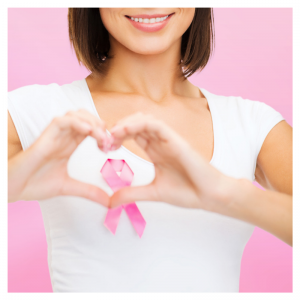A regular monthly breast self-exam is very important. Self-exams help you to be familiar with how your breasts look and feel so you can alert your healthcare professional if there are any changes.
Pick the same time every month, as your breasts change throughout your cycle. It is most comfortable after your cycle when your breasts are not tender. Follow these steps below:
Step 1: Start by looking at your breasts in the mirrorwith your shoulders straight, arms by your side, and then with your arms on your hips.
While looking in the mirror become familiar with the normal shape, size, and color of your breasts.
- Your breasts should be evenly shaped with no visible lumps, bumps, dimpling, or swelling
- Lumps under the surface can be normal. Breasts can be cystic. Get to know lumps that are normal for you and watch for changes in size, shape, or firmness.
- It is normal for your breasts to be asymmetrical as long as this is normal for you and does not abruptly change.
If you see any of the following changes, bring them to your doctor’s attention:
- Dimpling, puckering or bulging of the skin
- A nipple that has changed position, has discharge, or has become inverted (pushed inward instead of sticking out)
- Redness, soreness, rash or swelling
- If ever in doubt ask your provider. You can never be too cautious with your health.
Step 2: Raise your arms and look for the same changes as above.
Step 3: Lightly squeeze the nipple between your thumb and pointer finger and check for any fluid (discharge) coming out of one or both nipples (this could be a watery, milky, or yellow fluid or blood).
Step 4: Check both breasts feeling for any lump, thickening or hardened knot. Feel your breasts while lying down.
- To do this, bend your left elbow and put your left hand behind your head to relax your muscles. Use your right hand to feel your left breast.
- Use a firm, smooth touch with the first few finger pads of your hand, keeping the fingers flat and together. Use a circular motion, about the size of a quarter. Cover the entire breast from top to bottom, side to side — from your collarbone to the top of your abdomen, and from your armpit to your cleavage.
- Follow a pattern to be sure that you cover the whole breast. You can begin at the nipple, moving in larger and larger circles until you reach the outer edge of the breast. You can also move your fingers up and down vertically, in rows, as if you were mowing a lawn. The up-and-down method is often easier and prevents missing areas of the breast.
- Be sure to feel all the layers of your breasts using different pressures: for the skin and tissue just beneath, use light pressure; use medium pressure for tissue in the middle of your breasts; use firm pressure for the deep tissue in the back. When you’ve reached the deep tissue, you should be able to feel down to your ribcage. It is very important to feel for lumps in your armpits and the top outer area of your breasts (use a clock and focus on the 9 to 12 o’clock area). This is often where lumps of concern are located. Switch sides and repeat.
Step 5: Finally, feel your breasts while you are standing or sitting. Many women find that the easiest way to feel their breasts is when their skin is wet, so they like to do this step in the shower. Cover your entire breast, using the same hand movements described in step 4. If the steps seem difficult hang a breast examination card in your shower. They serve as a reminder with easy instructions.
If you notice any changes to your breasts call your healthcare provider to have them evaluated. For additional peace of mind, our nurses are available for a quick breast health check for our patients.
Current patients, if you have any concerns or would like to be shown how to do your own self-exam, please contact us to set up a quick complimentary appointment with one of our Nurses.

